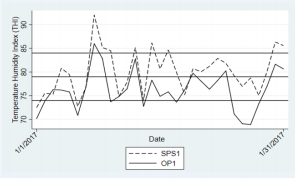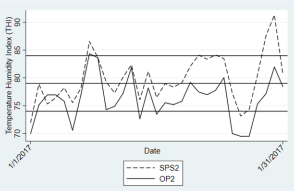THI: Is it a Reliable Measure to Assess Cattle Thermal Stress in Silvopastoral Systems in a Subtropical/ Temperate climate?
Introduction
In many parts of the world, beef production is performed under extensive conditions. In most of the tropical regions, those systems are characterized by having a monoculture of grasses and the absence (or small presence) of trees for shade [1,2]. This has promoted the concern that livestock performance and welfare may be adversely affected by weather conditions, heat stress being a sign of deterioration of animal welfare. The positive effect of shade is well demonstrated by the physiological and productive variables of the livestock in these productive conditions [3,4]. In subtropical and temperate zones like Australia, New Zealand, Argentina, Brazil and Uruguay, extensive cattle production systems are based on natural grassland management but the; large extension of the farms, the high number of animals and the need to access fresh natural pastures, make it impossible to provide artificial shelters in each open pasture (OP) paddock, some of them being more than 150 ha [5]. Meanwhile, in some months of the year, high temperatures, high humidity values, plus solar radiation during the day, promote environmental conditions in which animals are unable to maintain body temperature [6]. These conditions being particularly harsh for Bos taurus cattle [7].
However, the effect of ambient temperature (Ta) and relative humidity (H) can be affected by different factors, such as age, sex, genotype, body condition and breed. The breed being one of the most important. Signs like respiration rate (RR), body temperature, changes of physiological and metabolic parameters amongst others, are considered as indicators of heat stress in cattle [8,9]. The temperature humidity index (THI) [10] is commonly used as an indirect indicator of the levels of heat stress in cattle, where THI values regarding heat stress are normal if THI ≤74, alert 75–78 THI, danger 79–83 THI and emergency (THI ≥84). A sign of heat stress in animals is the increase in the respiration rate (RR); number of breaths per minute. Therefore, when animals are in large paddocks and in extensive conditions, an acceptable way to record heat stress signs is the observation of panting; the quick breathing through animal’s mouth. Data from tropical countries and recently from subtropical and temperate zones reported that Silvopastoral Systems (SPS) have a beneficial effect on animals from the welfare point of view. They generate a microclimate, providing protection against solar radiation and strong winds for animals, mainly due to the forest component [11,12]. Aiming to characterize the effect of THI on European beef cattle either in SPS or in open pasture (OP) environments by comparison, we evaluated THI scores during one complete year (four seasons) in extensive farms in Uruguay.
Materials and Methods
Paddocks
We worked on a 500 ha commercial farm located in a region of gentle slopes with disperse outcrops of rocks in the department of Florida (33°55’6.88”S, 55°34’13.92”W), Uruguay. Four paddocks were selected, two of them consisting of open pasture and the remaining two of SPS with a plantation design 2x2x7 (two lines of trees with a 2m distance between them and 7 m distance between the next two lines), with a density of 848 trees/ha. The two paddocks of OP (OP1 and OP2) had 30.4 ha and 18.7 ha respectively. One hectare of older trees is found in the middle of the two paddocks for shade and shelter purposes only and not as a forestry plantation. The SPS paddocks (SPS1 and SPS2) had 23.3 ha and 26.2 respectively.
Temperature and Humidity Records
Two pairs of sensors (I-button “Hygrochron” DS1923) were installed in a white wooden box with the open side facing south; the box was placed on a column at 2m height. Every sensor registered air temperature (T) and relative humidity in the air (RH) every six hours, starting at 00:00 every day for a whole month (January). One pair had one sensor in OP1 and another in SPS1, the remaining pair had a sensor in OP2 and another in SPS2. The topography of the terrain was considered aiming to maximize similarities between the sensor in the OP and the sensor in the SPS for each pair.
Animals
We worked with 2 categories of animals; three year old cows and two year old steers, all of them Bos taurus (Hereford breed). From these, four groups of animals were assigned each to one paddock. 31 cows (364kg SD 41) to OP1, 31 steers (313kg SD 29) to OP2, 18 cows (380kg SD 44) to SPS1 and 23 steers (315kg SD 27) to SPS2.
Observations
Observations were performed during the summer of 2017 (January). Every day at 12:00 pm a visual scan of the group was performed. Classifying animals as panting if at least one animal was quick breathing through the mouth (adapted from the panting scores proposed by Davis & Mader [13].
Statistical Analysis
THI was calculated for each sampling point using the equation proposed by Thorn (1959) THI= 0.81 T + RH (T-14,4) + 46.4. The THI value for each sampling point was compared with the THI value registered by the other sensor of the pair. Paired t test was used to compare differences between THI values in both pairs of sensors.
A General Linear Model (GLM) of the Binomial family was used with proportion of animals panting per group as the response variable and paddock, system, day of observation and THI as the factor variables. The differences were considered significant at p<0.05. The data was processed and analyzed with Stata 15 (Stata Corp).
Results
Figures 1 & 2 show THI performance at midday during January 2017 for both trials (SPS1/ OP1 and SPS2/OP2). Means and Standard Errors of both trials are following: OP1 76.2±0.74 and SPS1 80.1±0.84; OP2 76.2±0.70 and SPS2 79.9±0.80. Differences of THI values between SPS and OP were significant for both trials p<0,0001. No panting animals were recorded during the observation period.
Discussion and Conclusion
THI values were over the alert and emergency levels for both OP and SPS, nevertheless the THI values for SPS were higher. The lack of signs of panting in the animals, when emergency levels of THI are reached and exceeded, suggest that these levels may not be adjusted with the animal real thermal experience. Some authors suggest that THI may not be a valid generalization to assess indirect heat stress in cattle and that its use depends on the productive and environmental conditions. Gomes da Silva [14] compared the correlation between five environmental indicators of heat stress with rectal temperature and RR in dairy cows, and found that THI is not the indicator that better correlates with the animal’s response when evaluated for high temperatures. The Equivalent Temperature Index (ETI) and the Heat Load Index (HLI) showed a positive correlation with the animal’s response. Both ETI and HLI, consider not only air temperature and relative humidity, but also wind speed is considered in the former and solar radiation in the latter. Previous work from Davis et al. [13] concluded that solar radiation and wind speed should be considered when working with THI. An increase of 1,6 km/h in wind speed or a 10% increase in cloud coverage should be reflected by a decrease of one unit in the THI values [8]. Thus, THI should be complemented with other environmental measures to better reflect the thermal stress in European cattle in silvopastoral systems and in subtropical/ temperate climate.
Study Regarding the Inhibition of Acetylcholinesterase by Isopropyl 4-Nitrophenyl Methylphosphonate-https://biomedres01.blogspot.com/2021/02/study-regarding-inhibition-of.html
More BJSTR Articles : https://biomedres01.blogspot.com




No comments:
Post a Comment
Note: Only a member of this blog may post a comment.